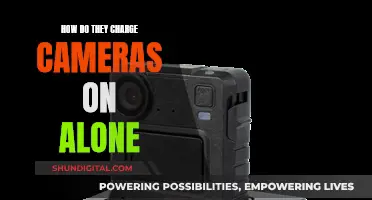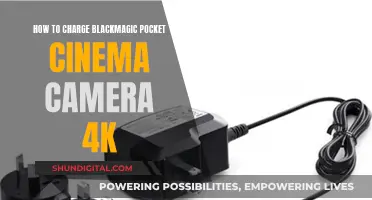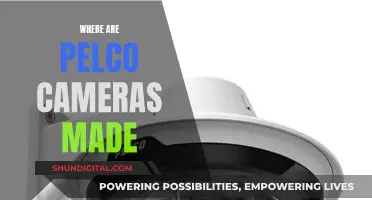
The thread standard for camera car mounts is a system of screws that attach a camera to a tripod. There are two standard sizes: 1/4-20 UNC and 3/8-16 UNC, which are part of the Unified Thread Standard (UTS). The 1/4-inch screw is used for most cameras and some lenses, while the 3/8-inch screw is used for larger professional cameras. The UNC refers to a coarse thread with a 60-degree profile. The number after the thread size refers to the number of threads per inch.
Characteristics and Values Table for Camera Car Mounts:
| Characteristics | Values |
|---|---|
| Number of thread sizes | 2 |
| Small thread size | 1/4-20 UNC |
| Large thread size | 3/8-16 UNC |
| Thread type | Coarse |
| Thread standard | Unified Thread Standard (UTS) |
| Thread profile angle | 60° |
| Screw head diameter | 12-14mm |
| Screw head thickness | 4mm |
| Screw shaft length | 10-17mm+ |
| Screw material | Stainless steel |
What You'll Learn

Screw thread sizes for camera mounts
There are two standard screw thread sizes for camera mounts: 1/4-20 UNC and 3/8-16 UNC. These are part of the Unified Thread Standard (UTS) and use imperial units of measurement. The number after the thread size refers to the number of threads per inch. UNC means that these are coarse threads in the Unified Thread Standard (the C stands for coarse).
The 1/4-20 UNC screw thread size is the most common and is used in most tripods, quick-release plates, and smaller cameras. It may also fit some lenses and LED panels. The 3/8-16 UNC screw thread size is used in larger professional cameras and modern equipment, as well as ball heads. This screw size is bigger and provides more stability.
Most camera bodies have a female thread, and most cameras have a 1/4-20 camera mount. However, larger cameras and lenses may be fitted with a 3/8-16 UNC thread and a removable 1/4-20 UNC adapter, allowing them to be mounted on a tripod with either thread size.
It is important to note that screw thread specifications must match for a secure fit. While some screw bolts may look similar in diameter, they are not necessarily compatible if their thread specifications differ.
Understanding PIR Mode on Trail Cameras: How Does It Work?
You may want to see also

Metric vs imperial standards
The standard camera tripod screw thread sizes are 1/4-20 UNC and 3/8-16 UNC, part of the Unified Thread Standard (UTS). The 1/4-inch screw size is for most cameras and some lenses, while the 3/8-inch screw is for larger professional cameras. The number after the thread size refers to the number of threads per inch.
The metric system and the imperial system are two different systems of measurement for things like distances, volumes, and weights. The metric system is a decimal system of units based on the metre as a unit of length, the kilogram as a unit of mass, and the second as a unit of time. It is also known as the International System of Units (SI). All but three countries in the world use the metric system.
The imperial system, on the other hand, consists of units such as the inch, the mile, and the pound. The British Imperial System was the official system of weights and measures used in Great Britain from 1824 to 1965. The United States Customary System (USCS) is based on the British Imperial System, and the term "imperial system" is often used to refer to both. Only three countries in the world use an imperial system of measurement: the United States, Liberia, and Myanmar.
The main difference between the metric and imperial systems is the type of units used. Metric units easily convert by multiplying or dividing by powers of ten, while there is no straightforward way to convert imperial units. For example, to convert between metric and imperial fluid ounces, you must multiply or divide by 1.8 and add or subtract 32.
The choice between the metric and imperial systems also comes down to history. In the early days of photography, The Royal Photographic Society suggested that the standard thread for cameras and tripods should be 1/4-20 BSW and 3/8-16 BSW, where BSW stands for British Standard Whitworth. BSW screw threads were used in photography until the early 1970s. In 1973, the International Organization for Standardization (ISO) issued ISO 1222:1973 as the new international standard for connecting cameras and tripods. Although ISO standards are usually metric, the official international standard for camera and tripod screw threads is an imperial standard.
The Highest-Resolution Cameras: Pushing Pixel Boundaries
You may want to see also

Tripod heads and their compatibility
Tripod heads are the part of a tripod that attaches a device, such as a camera, to the tripod legs. They allow the orientation of the device to be manipulated or locked down. There are several types of tripod heads available, each with its own unique features and compatibility options.
The most traditional type of tripod head is the three-way or pan-and-tilt head, which has three control arms for adjusting the position of the head on a vertical, horizontal, or panning axis. These heads offer precise movements and are easy to use, but they tend to be bulky, making them less suitable for travel.
Ball heads, on the other hand, offer more freedom of movement and are generally more compact. They typically have a single control knob for tightening or loosening the joint, allowing for quick and easy repositioning of the camera. Some ball heads also feature additional controls, such as panning bases and adjustable friction knobs, for more precise adjustments.
Pistol grip heads are a variation of ball heads that use a spring-loaded squeeze grip instead of a knob to tighten the housing around the ball. They offer simplicity and speed but usually have a lower weight capacity than other types of heads.
Geared heads, as the name suggests, feature gears on each axis that allow for very fine and precise adjustments. However, they tend to be heavier and more complex than other types of heads, and the process of repositioning the camera is relatively slow.
Gimbal heads are designed for use with large and heavy telephoto lenses, providing a balance and ease of motion that is ideal for wildlife and sports photography. They allow for rapid movements to track fast-moving subjects and can balance the camera and lens within the tripod head, simulating a "weightless" feel.
When choosing a tripod head, it is important to consider the weight and load capacity, the handles or controls, and the plate and quick-release mechanism. The weight and load capacity of the tripod head should be appropriate for your chosen camera and lens combination, while the handles or controls should be made of a material that is easy to grip and use, even in cold weather or when wearing gloves.
Additionally, most cameras have a 1/4" tripod mounting thread, but some have a 3/8" thread, so it is important to ensure you get the correct size for your camera. Using the wrong screw can damage the camera mount.
Galaxy S9 Plus: Night Mode Missing from Camera
You may want to see also

History of camera mount thread standards
The standard camera mount thread sizes are 1/4-20 UNC and 3/8-16 UNC, part of the Unified Thread Standard (UTS). The 1/4-inch screw size is used for most cameras and some lenses, while the 3/8-inch screw is used for larger professional cameras. The number after the thread size refers to the number of threads per inch.
Historically, The Royal Photographic Society recommended the thread standard for attaching older cameras to tripods was 3/16-24 BSW (3/16-inch nominal diameter, 24 threads per inch), or 1/4-20 BSW for smaller cameras and 3/8-16 BSW for larger cameras and pan/tilt heads. BSW screw threads were used in photography until the early 1970s.
In 1973, the ISO (International Organization for Standardization) issued ISO 1222:1973 as the new international standard for connecting cameras and tripods. The standard was updated in 2010 and reviewed in 2020 as ISO 1222:2010. Despite the ISO standards usually being metric, the official international standard for camera and tripod screw threads is an imperial standard.
Evading a Camera Ticket: My Story of Persuasion
You may want to see also

The Unified Thread Standard (UTS)
UTS defines a 60° thread form in inch dimensions, with the same profile as the ISO metric screw thread. However, the basic dimensions of each UTS thread are chosen as an inch fraction rather than a millimetre value. This means that the pitch, or distance between thread peaks, is given in threads per inch (TPI) rather than in millimetres. The pitch value is the reciprocal of the TPI. For example, a bolt with 20 TPI has a pitch of 1/20 inch.
The standard designation for a UTS thread includes the nominal (major) diameter of the thread, followed by the pitch measured in TPI. For diameters of 1/4 inch or larger, the diameter is given in inch fractions, such as 1/4", 3/4", or 1 1/4". For diameters smaller than 1/4", the diameter is indicated by an integer number from #0 to #12.
The UTS includes three thread series: Unified Coarse Thread (UNC), Unified Fine Thread (UNF), and Unified Extra Fine Thread (UNEF). UNC bolts are used for mass production and applications that require rapid installation, with more space between the threads allowing for variation in manufacturing. UNF threads are used in applications that require tighter and finer threads, such as aerospace and automotive. UNEF threads are used for tapped holes in hard materials, thin walls, and thin materials.
UTS also defines thread tolerance classes, ranging from Class 1 (loose fit) to Class 5 (interference fit). Class 2 threads are the most common, providing a free fit and maximising strength, while Class 3 threads have a closer tolerance for high-quality work.
Mobile Camera Focus: The Science Behind It
You may want to see also
Frequently asked questions
The thread standard for camera car mounts is the Unified Thread Standard (UTS), which includes two screw thread sizes: 1/4-20 UNC and 3/8-16 UNC. The former is for most cameras and some lenses, while the latter is for larger professional cameras.
UNC stands for coarse threads in the Unified Thread Standard. It is based on the imperial unit of the inch and has a symmetric 60-degree thread profile.
Yes, the standard tripod bolt thread for attaching a camera is either 1/4-20 UNC or 3/8-16 UNC, as per ISO 1222:2010. Most consumer cameras use the former, while larger professional cameras may have the latter.
The difference lies in their size. 1/4-20 UNC is smaller and suitable for most cameras, while 3/8-16 UNC is larger and used for professional cameras and certain tripod heads.
Yes, larger cameras with a 3/8-16 UNC screw hole are typically supplied with a 1/4-20 UNC adapter, allowing them to be mounted on tripods with either of the standard thread sizes.







